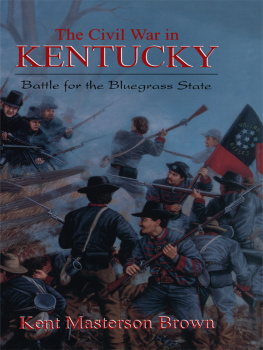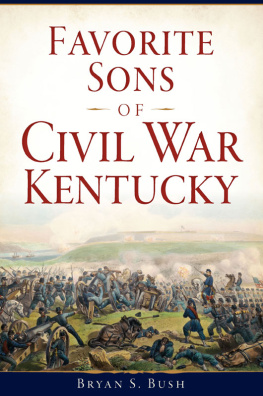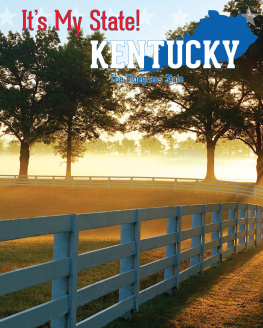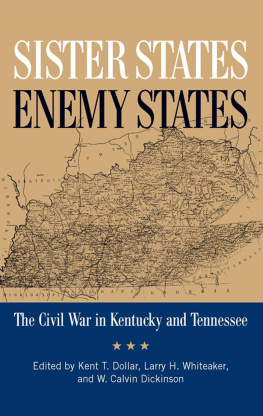Introduction
K entucky is a land of contrasts. From the Appalachian plateau to the Bluegrass to the Barrens and the Mississippi River bluffs, Kentuckys geography is notable for its remarkable variations. With mountains as well as sprawling flatlands, the Bluegrass State is drained by the largest number of navigable streams of any state in the Union. Occupying these varied lands in 1861 were different peoples sustained by widely varying regional economies. Although the Ohio River forms its northern boundary and its economy was in many respects tied to Ohio, Indiana and Illinois, Kentucky, nevertheless, considered itself a Southern state. Despite its close economic ties to Northern states, Kentucky remained a land of slaves, slaveowners and, for many years, a vigorous slave trade. Tobacco, hemp, grain and livestock were its staple crops.
This varied land produced both Abraham Lincoln and Jefferson Davis. Both men, as presidents of the contending sections during the Civil War, vied for Kentuckys loyalty. Many families in the state were bitterly divided. Brother fought against brother. The Bluegrass States tragedy even reached the White House. Lincolns wife, a Kentuckian, hailed from a slaveowning family whose sons fought and died for the Confederacy. One fell in battle at Shiloh, another fell near Baton Rouge, Louisiana. Confederate Gen. Benjamin Hardin Helm, commander of the Orphan Brigade who fell at Chickamauga, was married to Mary Todd Lincolns half-sister, Emily. Lincoln, it was recorded, wept upon hearing of Helms death.
Notable Confederate generals such as Albert Sidney Johnston, John Cabell Breckinridge, Simon Bolivar Buckner, William Preston, John Bell Hood, George Bibb Crittenden, Charles W. Field, John Hunt Morgan and Basil W. Duke were Kentuckians. Noted Union generals such as Thomas Leonidas Crittenden (George Bibb Crittendens brother), Lovell H. Rousseau, Thomas John Wood, William Bull Nelson, John Buford and Speed S. Fry, to name a few, as well as Maj. Robert Anderson, whose occupation of Fort Sumter touched off the war, were Kentuckians.
The Orphan Brigade and John Hunt Morgans cavalry were noted Kentucky Confederate commands. The Union raised vast numbers of infantry, artillery and cavalry regiments in the Bluegrass State, most of which saw action at Shiloh, Stones River, Vicksburg, Chickamauga, Chattanooga, Atlanta, Franklin, Nashville and elsewhere. Nearly 80,000 Kentuckians fought in the Union armiesmore than three times the number of Kentuckians who took up arms for the Confederacy.
To successfully prosecute the war, Lincoln had to secure Kentucky for the Union. His designs on Kentucky became evident at the very outbreak of hostilities. When Confederate Gen. Leonidas Polk seized Columbus, Kentucky on the Mississippi River, Union forces under Gen. Ulysses S. Grant took the mouths of the Tennessee and Cumberland Rivers at Paducah and Smithland, respectively, in the fall of 1861. Lincolns armies were then in a position to penetrate Kentucky and Tennessee by ascending the northward-flowing Tennessee and Cumberland Rivers.
General Albert Sidney Johnston, from his Department No. 2 headquarters at Bowling Green, struggled to hold the Bluegrass State for the Confederacy. Kentuckys geography, coupled with the size and power of Johnstons enemyincluding its freshwater navy with troop transports and ironclad and timberclad gunboatscombined to cripple his efforts. After the disastrous battle at Mill Springs in southeastern Kentucky on January 19, 1862, the forces of Gen. George Bibb Crittenden, which held the right wing of Johnstons Confederate defensive line, withdrew through rain and sleet into Tennessee. Grant seized the opportunity to move upstream, putting his Army of the Tennessee in motion. General Johnstons thin Confederate line was shattered in bitter cold and wet weather with the fall of Fort Henry on the Tennessee River on February 6, and the fall of nearby Fort Donelson on the Cumberland River on February 16 just below Kentuckys southern border. Johnston withdrew the remainder of his army from Bowling Green to Nashville, Tennessee. General Polks forces withdrew from Columbus down the Mobile & Ohio Railroad into Tennessee. The Bluegrass State was abandoned by Confederate forces.
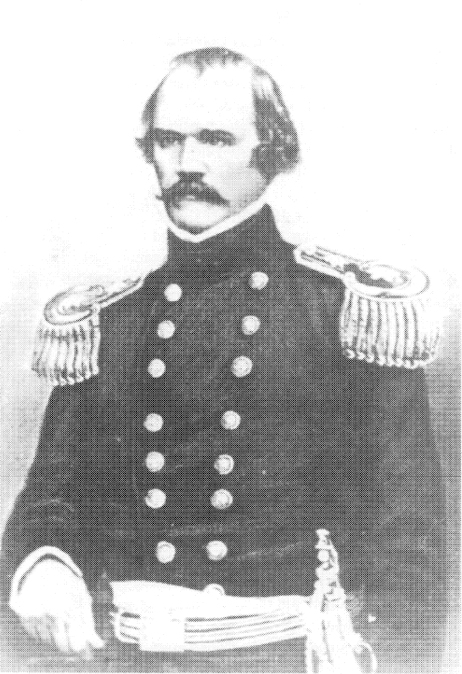
Library of Congress
Ultimately, Johnston collected his widely-scattered forces below the great southern bend of the Tennessee River at Corinth, Mississippi, the site of the crossing of the Mobile & Ohio and Memphis & Charleston railroads. Union General Don Carlos Buells Army of the Ohio marched into Nashville while Grants army ascended the Tennessee River. Moving out from Corinth, Johnston struck Grants forces on April 6, 1862 near a site along the Tennessee River called Shiloh Church. Significant Confederate battlefield advances on the first day stalled with Johnstons fatal wounding. Grant, reinforced by Buells Army of the Ohio, counterattacked the following morning, retaking lost ground and sealing a Union victory. More than 20,000 men fell at Shiloh, the bloodiest two days of the war to date.
After the Battle of Shiloh the Confederate army withdrew back to Corinth and then to Tupelo, Mississippi. General Braxton Bragg (who took over command of the newly named Army of the Mississippi at Tupelo) and Gen. Edmund Kirby Smith (who commanded a Confederate army at Knoxville, Tennessee) launched in the summer and fall of 1862 the wars longest and most strategically complex operation to retake the Bluegrass State for the Confederacy. In the midst of a devastating three-month drought, Braggs and Kirby Smiths armies entered Kentucky without any significant opposition, Bragg following the Louisville & Nashville Railroad into central Kentucky and Kirby Smith following the old Wilderness Road into eastern and central Kentucky. But Union General Don Carlos Buell and his Army of the Ohio raced from Nashville to Louisville, Kentucky to meet the threat, and new levies poured into the Bluegrass State from Illinois, Indiana, Ohio and other Union states.

